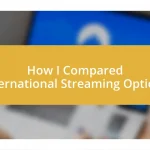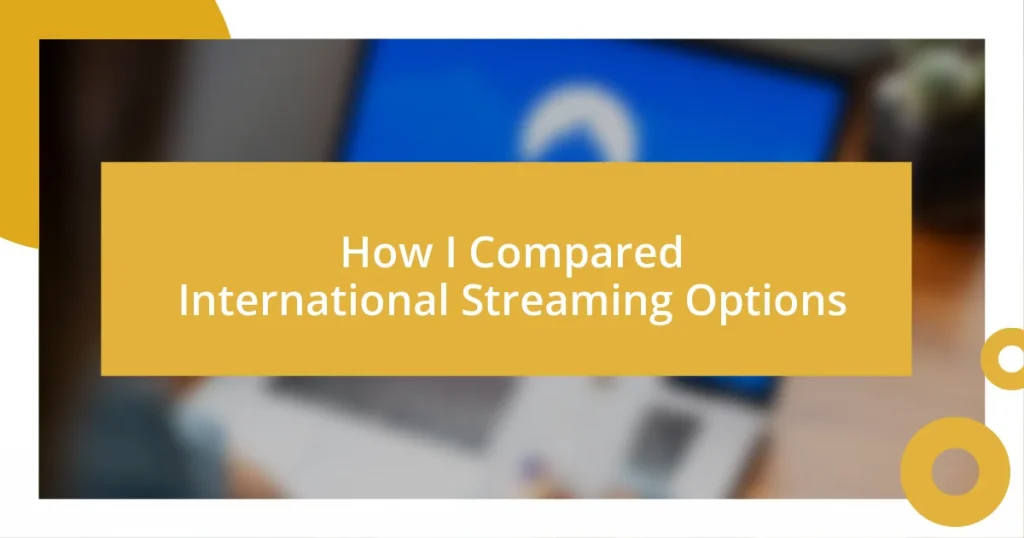Key takeaways:
- Choosing an international streaming service requires careful consideration of content availability, user experience, and pricing to ensure it aligns with personal viewing preferences.
- Regional availability can significantly affect access to content, highlighting the need for potential solutions like VPNs to bypass geo-restrictions.
- Prioritizing platforms with intuitive interfaces and personalized recommendations enhances the overall viewing experience, making navigation and content discovery more enjoyable.
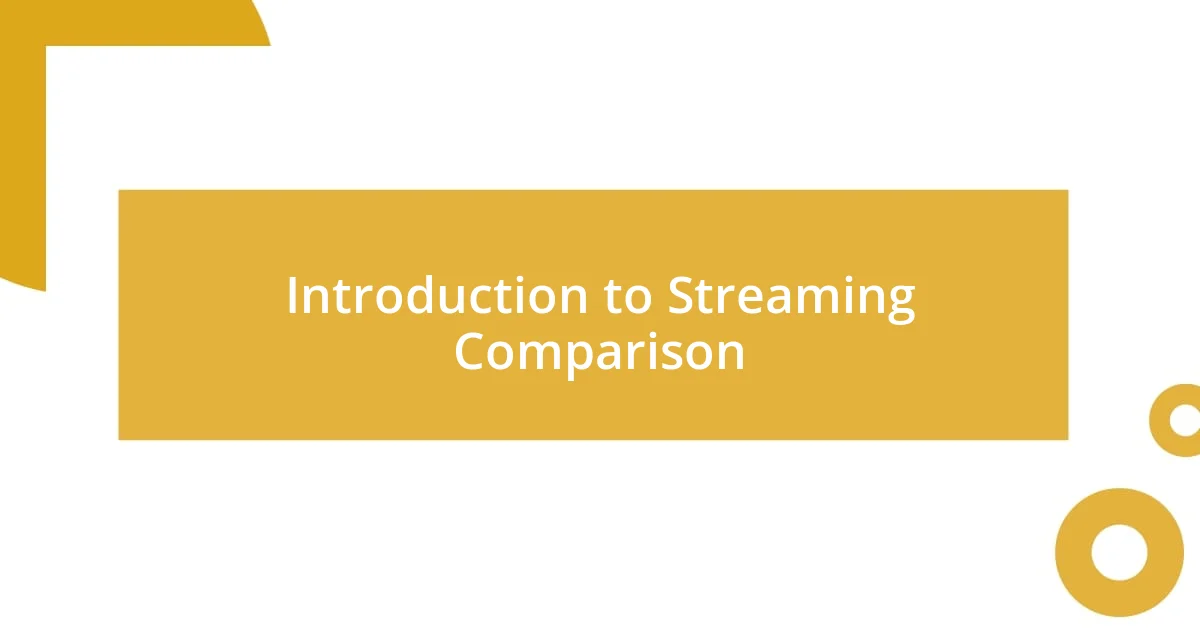
Introduction to Streaming Comparison
As I delved into the world of international streaming options, I couldn’t help but feel a mix of excitement and overwhelm. With so many platforms vying for attention, how does one even begin to choose? My own journey started with a single question: which service offers the best value for my viewing preferences?
I vividly remember comparing platforms late one evening, armed with snacks and a growing list of must-see shows from different countries. Each option presented its own unique offerings, but it was the subtleties in content variety and accessibility that really stood out. Have you ever felt like a kid in a candy store, only to be paralyzed by choice? That was exactly my experience, and it reinforced just how important it is to compare these services carefully.
Through my exploration, I discovered that understanding regional availability and content libraries is crucial for making informed decisions. It’s not just about what’s popular; it’s about what resonates with you personally. Let’s face it, sometimes the perfect show is buried under heaps of mainstream hits—ever found a hidden gem that left you speechless? That’s the thrill of finding the right streaming option!

Criteria for Selecting Services
When evaluating international streaming services, I leaned heavily on a few key criteria that influenced my choices. I found that factors like content availability, user interface, and pricing were essential in guiding my decision-making process. It’s like trying to find the perfect restaurant; the atmosphere counts just as much as the menu options.
Here are the main criteria I considered:
- Content Library: What shows and movies are available? Do they cater to my interests?
- Regional Access: Are there any geo-restrictions that might limit my viewing experience?
- User Experience: How intuitive is the interface? Is it easy to navigate and find what I’m looking for?
- Cost-Effectiveness: Does the price justify the content available? Are there any hidden fees?
- Device Compatibility: Can I watch on multiple devices?
Every time I discovered a platform that aligned with my needs, I felt a sense of accomplishment. Finding the right streaming service made me feel like I’d just solved a puzzle. It’s crucial to weigh these elements because they significantly impact your overall enjoyment and satisfaction.
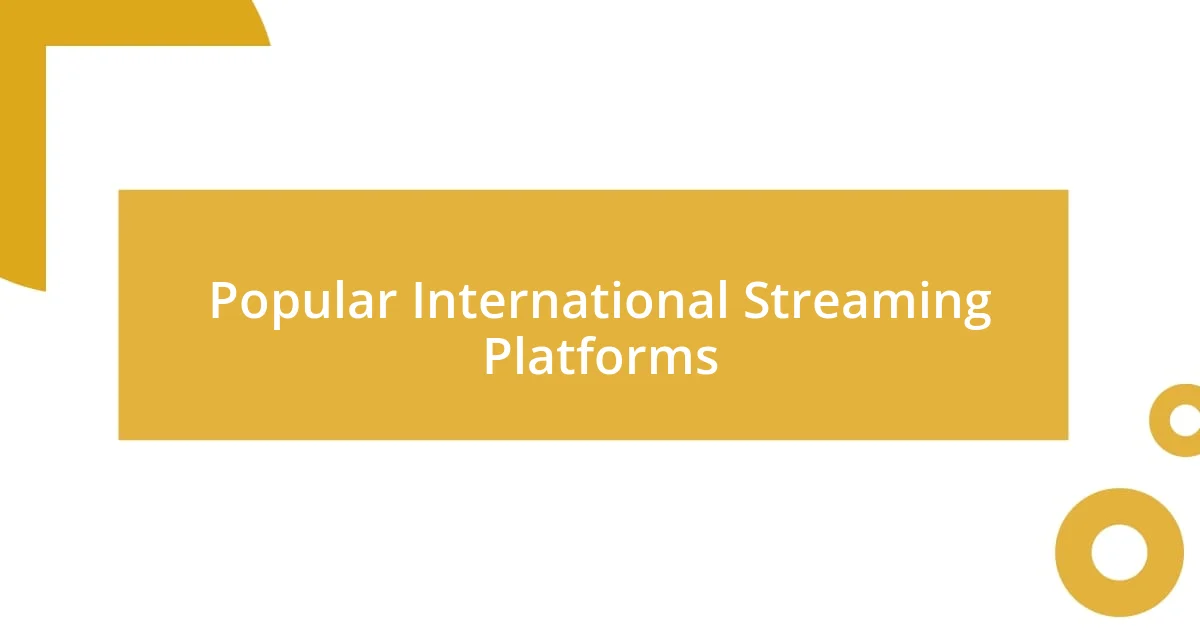
Popular International Streaming Platforms
When exploring popular international streaming platforms, I quickly realized that each service has its own unique flavor. For instance, Netflix offers an impressive array of content from around the globe, continually expanding its library with original programming that often feels like a cultural treasure trove. I remember the thrill of binging a gripping Korean drama one night and reflecting on how the platform’s international presence embraced diverse stories in a way that truly resonated with me.
On the other hand, Amazon Prime Video caught my eye for its robust selection of films, including indie titles I never would have discovered otherwise. I distinctly recall how a random film suggestion on Prime led me down a rabbit hole of independent cinema, making me appreciate the depth and variety available. It’s moments like these that reveal just how much value these platforms can add to our viewing experiences.
Disney+, while heavily centered on popular franchises, doesn’t shy away from offering international flavors through its global collections. I was pleasantly surprised by their selection of animated films from different cultures, which reminded me of nights spent watching classics with my family. The nostalgia intertwined with exploration made me realize how important it is to find platforms that not only entertain but also connect us to broader worlds and perspectives.
| Platform | Key Features |
|---|---|
| Netflix | Diverse content library, originals from various countries |
| Amazon Prime Video | Extensive film selection, including independent titles |
| Disney+ | Franchise favorites, international animated films |

Regional Availability of Content
Regional availability of content can be a real game-changer when it comes to choosing a streaming service. I was amazed to find that the same show could have entirely different seasons or episodes depending on where I logged in from. For example, while binge-watching my favorite series, I noticed that some episodes were available in one region but not in another. It made me wonder—why is the content locked away like that?
What really stands out is how these geo-restrictions shape our viewing habits and preferences. I remember trying to access a much-talked-about documentary only to be met with a “not available in your region” message. That frustrating moment led me to explore VPNs, which can help bypass these barriers, but isn’t it disheartening that I even had to consider that option just to catch up on something everyone else seemed to enjoy?
In my experience, the thrill of discovering new content is often curtailed by these regional limitations. I once had a friend visiting from another country who couldn’t access some of the streaming platforms I took for granted. We ended up watching old DVDs instead! It left me pondering just how much our viewing experiences could be enriched if services broadened their horizons, allowing us to explore content from all over the world without any restrictions.
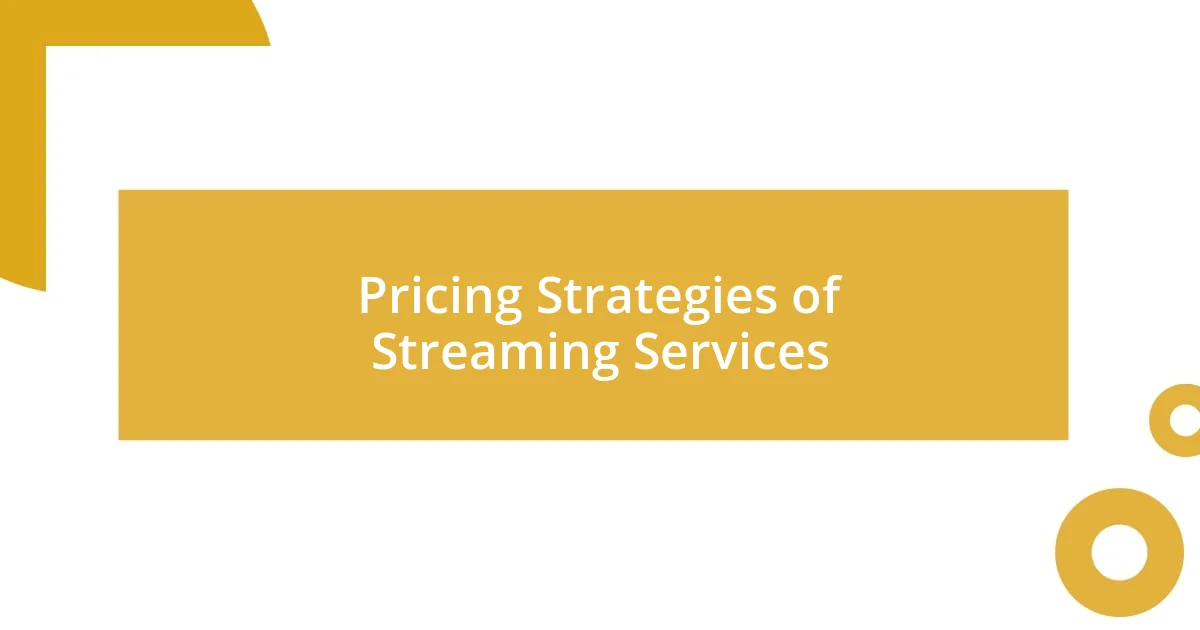
Pricing Strategies of Streaming Services
Pricing strategies among streaming services often reflect their target audience and the unique value they offer. For example, I’ve noticed that Netflix employs a tiered pricing model, which gives users flexibility based on their needs—whether it’s watching on a single screen or enjoying ultra-high-definition content across multiple devices. This approach not only caters to different budgets but also creates a sense of ownership over the viewing experience.
Comparing this to Disney+, I found their competitive pricing particularly appealing. During my family’s movie night, it was remarkable how affordable the subscription felt, especially given the wealth of family-friendly content. It got me thinking—does a lower price point inherently suggest lower quality, or can it be a strategic move to build a loyal audience? Disney’s strategy certainly seems to position them as an accessible choice for families, encouraging those new to streaming to dive in without breaking the bank.
Additionally, platforms like Hulu have experimented with ad-supported options, making the service available at a fraction of the cost. I remember signing up for a trial, weighing the trade-off of enduring commercials for a lower price. It sparked a debate in my mind: is saving money worth interrupting the flow of a good show? This pricing strategy not only expands their user base but also raises interesting conversations about consumer preferences and the lengths we go to for entertainment.

User Experience and Interface
User interfaces across different streaming platforms can vary significantly in terms of usability and design. I’ve experienced some platforms that felt intuitive and clutter-free, making it a breeze to navigate through genres and find new content. For instance, I chuckled the first time I used a service that had an endless scroll of recommendations—so many choices! But there were moments of frustration too, like when I accidentally clicked on a show I had no interest in, only to find myself stuck in an awkward trailer loop. That experience made me appreciate clean designs that prioritize user flow and minimize unnecessary clicks.
Then there are the personalized features that make a service truly shine. When I discovered a streaming app that curates a tailored watchlist based on my previous viewing habits, it felt like it was reading my mind! Those moments when I’m recommended new favorites often lead to delightful surprises, but I sometimes wonder—what happens when the algorithm misses the mark? I recall a time when I was bombarded with action movie suggestions, but my heart was set on a light-hearted rom-com. The disconnect made me question how well these platforms understood their users.
Moreover, the experience of buffering or low-quality playback can sour the most compelling content. I remember settling in for a binge-watch session, only to be greeted by an endless loading wheel. That frustration pulls you out of the moment and completely disrupts the experience. It often leads me to reflect—shouldn’t a seamless experience be the baseline expectation for all streaming services? Ultimately, I believe that both user interface and consistent performance are paramount in creating a satisfying and engaging viewing environment.

Conclusion and Recommendations
When it comes to international streaming options, my findings suggest that consumers should prioritize platforms that not only fit their viewing preferences but also align with their budgets. From my own experiences, having a clear idea of what content you enjoy helps in navigating the myriad of choices. Have you ever signed up for a service in the excitement of new releases, only to find it lacking your favorite genres? That’s why I recommend starting with free trials whenever possible; it allows you to explore the library without commitment.
I’ve learned through my own trials that user experience can make or break your streaming enjoyment. A mind-boggling interface can turn even the most intriguing show into a tedious search. I still vividly remember the time I spent more time scrolling than watching, and it made me appreciate services that prioritize simplicity and ease of navigation. Therefore, I’d suggest evaluating not just the content but also how manageable the platform feels to navigate.
Ultimately, it seems clear to me that each streaming service has its unique strengths and weaknesses. My ideal recommendation is to consider what features truly enhance your viewing experience—whether it’s content variety, user interface, or pricing options. Reflect on your own needs and preferences. How much do you value the breadth of content versus ease of access? In the end, the best choice is the one that enriches your entertainment journey while fitting comfortably into your lifestyle.




